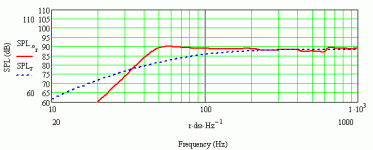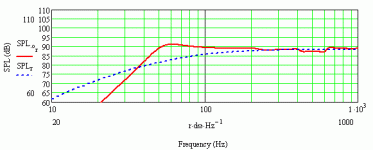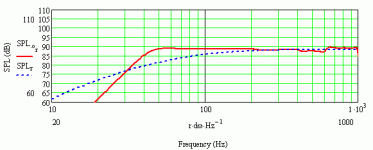I don't know much theory but have been experimenting with some simple listening tests and port lengths for the GM MLTL. Original build has a 2 in x 4 in. port out the bottom.
Opposite channel has a 2 in x 3 in port also on bottom.
24 gauge solid copper wire (high resistance) used both sides. Interior treatment the same: above driverr with pillow batting fiber fill and along one wall.
What's puzzling is one sounds louder than the other on test tones.
I'm 60 with is another variable for hearing loss.
What would show a noticeable difference in volume of like units installed in the same design with only wire and port length dissimilar?
Opposite channel has a 2 in x 3 in port also on bottom.
24 gauge solid copper wire (high resistance) used both sides. Interior treatment the same: above driverr with pillow batting fiber fill and along one wall.
What's puzzling is one sounds louder than the other on test tones.
I'm 60 with is another variable for hearing loss.
What would show a noticeable difference in volume of like units installed in the same design with only wire and port length dissimilar?
Cal Weldon said:Are all frequencies louder on one channel? I have been fooled in the past. First I turn around and listen with them at my back. If that doesn't work I swap the speakers and try again.
According to your post the wires are both the same and different. Did I miss something?
Yeah, foolish me. After I made the post I thought about reversing the amp connection. I just don't think my hearing is that off.
As I raise the test tone frequency, I can hear the 'quieter one' come up in volume but always always one is louder on a side to side test.
I'll reverse 'em and check again.
Also puzzled by the original port design which is smaller and shorter. I did not care for this and when I hit on 2in x 4 in. long I stuck with it. GM said that it was to achieve lower frequency but I found it to be muddy in practice. I have no test gear and am fairly theory illiterate (even after having been on forums for some time.)
Helmholtz frequency

this is the equation that "governs" the behaviour of air in port, the change is "L" , the length of the port
Everything else being equal, sqrt(1/3)>sqrt(1/4) by some 15%...so the tuning frequency will be lower by 15%.
An example... if the L=4" port speaker is tuned to say 40Hz, then the L=3" port would be tuned to 34Hz. This difference is easily enough to hear.
stew

this is the equation that "governs" the behaviour of air in port, the change is "L" , the length of the port
Everything else being equal, sqrt(1/3)>sqrt(1/4) by some 15%...so the tuning frequency will be lower by 15%.
An example... if the L=4" port speaker is tuned to say 40Hz, then the L=3" port would be tuned to 34Hz. This difference is easily enough to hear.
stew
You don't specifiy which MLTLs (or drivers) you've got currently, but by shortening the vent, you will raise both the tuning frequency & also reduce the damping of the cabinet as less resistance is placed on the internal standing waves.
So, the cabinet with the shorter vent will indeed sound louder in the LF at least (though it won't go as low), probably exhibit a little more ripple higher up as there is less attenuation of pipe harmonic modes, and perhaps a little less compression of the LF, though those last will be very subjective.
For example, here's GM's MLTL31 cabinet (IIRC he advises a 2in x 5in vent for a max-flat response & adjust to taste from there for that particular box) with a 2in x 4in vent:
So, the cabinet with the shorter vent will indeed sound louder in the LF at least (though it won't go as low), probably exhibit a little more ripple higher up as there is less attenuation of pipe harmonic modes, and perhaps a little less compression of the LF, though those last will be very subjective.
For example, here's GM's MLTL31 cabinet (IIRC he advises a 2in x 5in vent for a max-flat response & adjust to taste from there for that particular box) with a 2in x 4in vent:
Attachments
It's my hearing.
I did the simple test of turning my back to the speaks and doing a/b tests that way. It verfies a simple hearing test I got a while back. the test was not thorough-- it was a promotional freebie.
The MLTL is the GM design for FE127e. 'Zilla made that with a side firing port. I used the example from the Jordan GM design and decided that the bottom firing port (and sticking out the bottom as well) gave the best effect. I tried an angled baffle at 45d at the port but that was disappointing too.
The idea of top firing or bottom firing ports comes from Martin King's notes. I have not read Augsburger. In his experiments with transmission line, King states (and correct me anyone if I got this wrong) that the air energy at the port is zero and the dispersion is at the terminus, not ballooning out as the front wave does. So getting the port in the horizontal plane rather than the more typical vertical (rear mounted, front mounted) should give better sound to the ear.
What I was trying to get was a shorter port on the bottom, protruding out, but able to sit on a low speaker stand or table height typical for a larger tv.
My method of setup for listening to this port out the bottom MLTL is to insert the port through a hole cut into a cheap screw together shelf stand typically sold in big box stores for $10 US. This has worked out amazingly well. Not ready for Better Homes and Gardens but this was never my goal.
Soon I will have the last side on the Harvey. Since the port on the Harvey is radically different from the MLTL I've heard a radical difference in sound. But that discussion has to go into the Harvey builder's thread.
The last listening test I did with the Harvey as dry clamp job I was using my 'good' ear side.

Properly sealed, I'm hoping to get it in shape to sound comparable or enhanced in relation to the BIB-- also for FE127e.
I did the simple test of turning my back to the speaks and doing a/b tests that way. It verfies a simple hearing test I got a while back. the test was not thorough-- it was a promotional freebie.
The MLTL is the GM design for FE127e. 'Zilla made that with a side firing port. I used the example from the Jordan GM design and decided that the bottom firing port (and sticking out the bottom as well) gave the best effect. I tried an angled baffle at 45d at the port but that was disappointing too.
The idea of top firing or bottom firing ports comes from Martin King's notes. I have not read Augsburger. In his experiments with transmission line, King states (and correct me anyone if I got this wrong) that the air energy at the port is zero and the dispersion is at the terminus, not ballooning out as the front wave does. So getting the port in the horizontal plane rather than the more typical vertical (rear mounted, front mounted) should give better sound to the ear.
What I was trying to get was a shorter port on the bottom, protruding out, but able to sit on a low speaker stand or table height typical for a larger tv.
My method of setup for listening to this port out the bottom MLTL is to insert the port through a hole cut into a cheap screw together shelf stand typically sold in big box stores for $10 US. This has worked out amazingly well. Not ready for Better Homes and Gardens but this was never my goal.
Soon I will have the last side on the Harvey. Since the port on the Harvey is radically different from the MLTL I've heard a radical difference in sound. But that discussion has to go into the Harvey builder's thread.
The last listening test I did with the Harvey as dry clamp job I was using my 'good' ear side.

Properly sealed, I'm hoping to get it in shape to sound comparable or enhanced in relation to the BIB-- also for FE127e.
Too much time spent with it. 
Re air at the port / terminus, & various effects, it rather depends on the design objectives as to what's best. In terms of the physics, you have a pressure node & displacement antinode at the open end of a line, and a pressure antinode & veolcity node at the sealed end. http://hyperphysics.phy-astr.gsu.edu/Hbase/hframe.html
Re air at the port / terminus, & various effects, it rather depends on the design objectives as to what's best. In terms of the physics, you have a pressure node & displacement antinode at the open end of a line, and a pressure antinode & veolcity node at the sealed end. http://hyperphysics.phy-astr.gsu.edu/Hbase/hframe.html
Port volume
A supplementary question to this thread: is it okay to reduce port length and increase the diameter to keep the same cubic volume in the port? For instance, if wanting to reduce the length of the 31" MLTL port from 5" to 2.5", I would have to increase the diameter to 4". Any trade offs?
A supplementary question to this thread: is it okay to reduce port length and increase the diameter to keep the same cubic volume in the port? For instance, if wanting to reduce the length of the 31" MLTL port from 5" to 2.5", I would have to increase the diameter to 4". Any trade offs?
Re: Port volume
Hi Colin, it doesn't work like that -- in fact, as you increase diameter, you also have to increase length. As Nanook noted above, ratios and square roots are involved (and it's not a matter of contant volume in the port).
Play with a port calculator to see (under "Calculate Your Vent Length"):
http://www.carstereo.com/help/Articles.cfm?id=31
Tradeoffs involve the velocity of air through the port -- smaller diameter means greater air velocity, which can result in "whooshing" noises if the velocity is too great.
But let's hear a guru weigh in on this, since I'm a newb and I'm just re-iterating what I've read.
Colin said:is it okay to reduce port length and increase the diameter to keep the same cubic volume in the port? For instance, if wanting to reduce the length of the 31" MLTL port from 5" to 2.5", I would have to increase the diameter to 4". Any trade offs?
Hi Colin, it doesn't work like that -- in fact, as you increase diameter, you also have to increase length. As Nanook noted above, ratios and square roots are involved (and it's not a matter of contant volume in the port).
Play with a port calculator to see (under "Calculate Your Vent Length"):
http://www.carstereo.com/help/Articles.cfm?id=31
Tradeoffs involve the velocity of air through the port -- smaller diameter means greater air velocity, which can result in "whooshing" noises if the velocity is too great.
But let's hear a guru weigh in on this, since I'm a newb and I'm just re-iterating what I've read.
- Status
- This old topic is closed. If you want to reopen this topic, contact a moderator using the "Report Post" button.
- Home
- Loudspeakers
- Full Range
- Puzzled by listening tests


